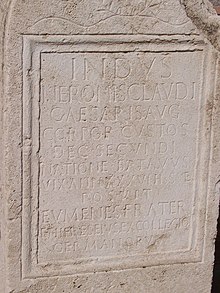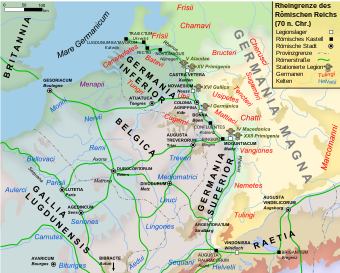Batavi (Germanic tribe)
Tacitus also reports that before their arrival the area had been "an uninhabited district on the extremity of the coast of Gaul, and also of a neighbouring island, surrounded by the ocean in front, and by the river Rhine in the rear and on either side".[6] Tacitus (De origine et situ Germanorum XXIX) described the Batavi as the bravest of the tribes of the area, hardened in the Germanic wars, with cohorts under their own commanders transferred to Britannia.The late fourth century writer on Roman military affairs Vegetius mentions soldiers using reed rafts, drawn by leather leads, to transport equipment across rivers.Despite the alliance, one of the high-ranking Batavi, Julius Paullus, to give him his Roman name, was executed by Fonteius Capito on a false charge of rebellion.The Batavi were still mentioned in 355 during the reign of Constantius II (317–361), when their island was already dominated by the Salii, a Frankish tribe that had sought Roman protection there in 297 after having been expelled from their own country by the Saxons.In the 16th-century emergence of a popular foundation story and origin myth for the Dutch people, the Batavians came to be regarded as their ancestors during their national struggle for independence during the Eighty Years' War.[11][12] The mix of fancy and fact in the Cronyke van Hollandt, Zeelandt ende Vriesland (called the Divisiekroniek) by the Augustinian friar and humanist Cornelius Gerardi Aurelius, first published in 1517, brought the spare remarks in Tacitus' newly rediscovered Germania to a popular public; it was being reprinted as late as 1802.[13] Contemporary Dutch virtues of independence, fortitude and industry were fully recognizable among the Batavians in more scholarly history represented in Hugo Grotius' Liber de Antiquitate Republicae Batavicorum (1610).The origin was perpetuated by Romeyn de Hooghe's Spiegel van Staat der Vereenigden Nederlanden ("Mirror of the State of the United Netherlands," 1706), which also ran to many editions, and it was revived in the atmosphere of Romantic nationalism in the late eighteenth-century reforms that saw a short-lived Batavian Republic and, in the colony of the Dutch East Indies, a capital that was named Batavia.


BataviaBataviGermanic bodyguardGermanicBetuweJulius CaesarCommentarii de Bello GallicoRhine riverLower RhineOld RhineTacitusChattiUsipetesTencteriDrususOppidumSmetius CollectionRembrandt van RijnChariovaldaCherusciDe origine et situ GermanorumBritanniaDio CassiusAulus Plautiusbattle of the River MedwayAmmianus MarcellinusCornutiAugustusEquites singulares AugustiYnys Mon (Anglesey)DruidsHadrian's WallCastlecaryCarrawburghYugoslaviaRevolt of the BataviGaius Julius CivilisCastra VeteraNabaliaLegio X GeminaConstantius IIConstantius GallusChamaviToxandriaLate Roman armyPassauHigh German consonant shiftDutch peopleEighty Years' WarHugo GrotiusRomantic nationalismBatavian RepublicDutch East IndiesJakartaBetawiOrang Betawitribal knowledgefounding mythFrisiansFranksSaxonsship BataviaLelystadGermanisation of GaulList of Germanic peoplesDrinkwater, John FrederickHornblower, SimonEidinow, EstherThe Oxford Classical DictionaryOxford University PressSimon SchamaSpeidel, Michael P.Germania InferiorGermanic peoplesEthnolinguistic groupNorthern EuropeanGermanic languagesNordic Bronze AgeGermaniaPre-Roman Iron AgeRoman Iron AgeRomano-Germanic cultureGermanic Iron AgeViking AgeEarly cultureArchitectureCalendarClothingFamilyFestivalsFolklore Proto-Germanic folkloreAnglo-Saxon mythologyContinental Germanic mythologyNorse mythologyFunerary practicesAnglo-SaxonLiteratureGothicNumbersPaganismGothic alphabetSymbologyWarfareGothic and VandalVikingLanguagesGermanic parent languageProto-Germanic languageEast Germanic languagesNorth Germanic languagesWest Germanic languagesGroupsAlemanniBrisgaviBucinobantesLentiensesRaetovariAdrabaecampiAnglesAnglo-SaxonsAmbronesAmpsivariiAngrivariiArmalausiAuiones